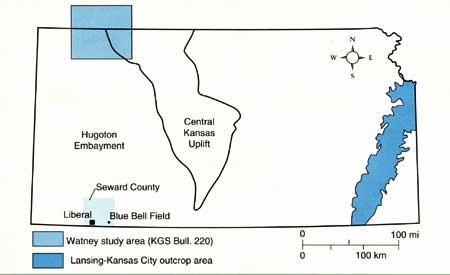| Kansas Geological Survey | Fall 1995 |
Vol. 1.2 |
|
Survey Research Aids Oil Exploration
CONTENTS Survey Research
|
Finding
oil is seldom easy. And in Kansas, where most of the major oil fields
have been discovered, it requires imagination and information. Wichita
geologist Paul Gerlach had both. In the early 1990s, starting with data generated by a study at the Kansas
Geological Survey, Gerlach developed five new wells in southwestern Kansas
that have produced more than 250,000 barrels of oil. The research that Gerlach used began in 1980, when Survey geologist Lynn
Watney made a detailed study of the deposition of the Lansing-Kansas City
Groups, formations deposited during the Pennsylvanian Period of geologic
history, about 300 million years ago. Watney looked specifically at a
rock layer called the Swope Limestone, already well known as an important
source of oil in many Kansas fields. Watney published his work in Kansas
Geological Survey Bulletin 220, Cyclic Sedimentation of the Lansing-Kansas
City Groups in Northwestern Kansas and Southwestern Nebraska—A Guide
for Petroleum Exploration, and in a guidebook from the Kansas Geological
Society. Gerlach read those publications and attended a short course on petroleum-resource
characterization that Watney taught in Wichita in 1986. He then acquired
additional geologic data to produce a detailed map of an area in southwestern
Kansas that he thought might be especially promising. “Lynn’s information was a beginning point,” said Gerlach.
“I built on that basic work to produce a high-quality prospect.” That prospect was in southern Seward County, east of Liberal, in a producing
area originally discovered in 1953 and known as the Blue Bell Field. In
1991, Gerlach used his newly developed information to drill a well that
initially produced 180 barrels of oil per day. Its production has since
stabilized at about 100 barrels per day. Gerlach later drilled four more
wells, and estimates that each of the five wells has produced approximately
50,000 barrels of oil. He believes they will eventually produce as much
as 80,000 barrels of oil. “That oil would probably still be in the ground if it hadn’t been for the combined efforts of an explorationist and scientists at the Survey,” said Survey director Lee Gerhard. “We provided the initial regional information, and Paul Gerlach added detailed information to work up the prospect. That’s exactly how the process ought to proceed. It is crucial that we continue to produce new knowledge and exploration techniques, and that we disseminate that information, to aid in the production of oil in the state. Paul Gerlach’s wells in Seward County are proof that the process works.” |
|
Location of Blue Bell Field, Watney's study area,
and the Lansing–Kansas City outcrop area. Modified from Watney,
1980. |
 |
| Online February 10, 2003 Comments to: lbrosius@kgs.ku.edu Kansas Geological Survey URL:http://www.kgs.ku.edu/Publications/GeoRecord/1995/vol1.2/Page1.html |